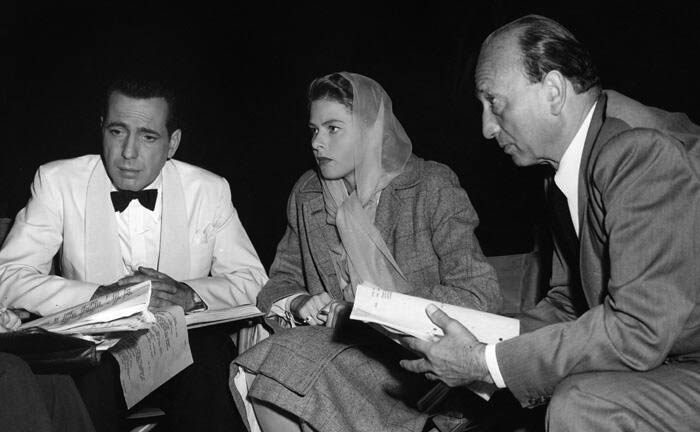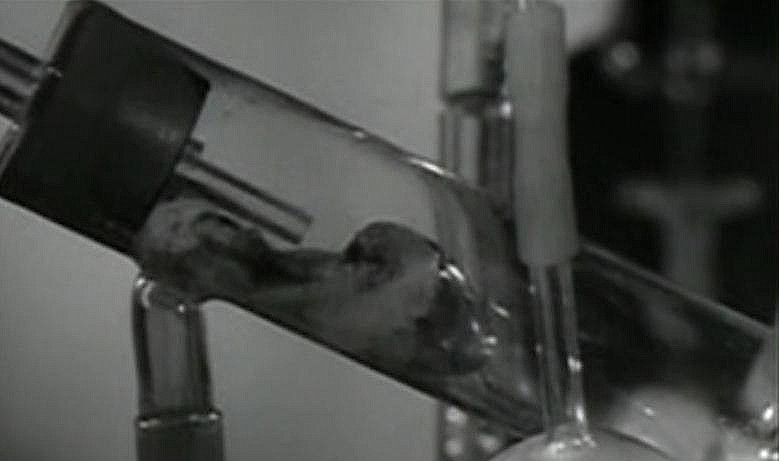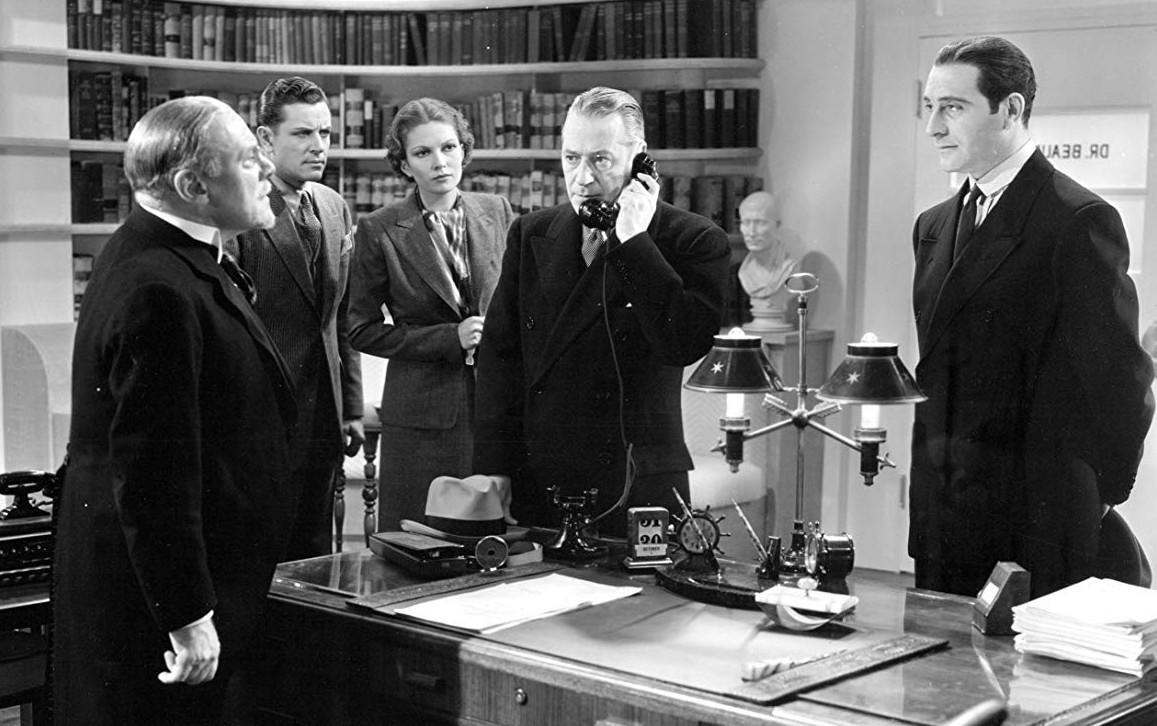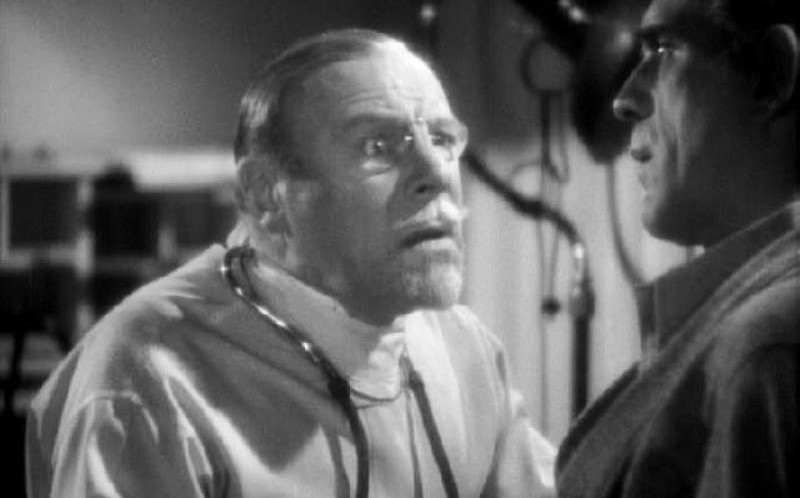No, this has nothing to do with the TV-series. This is a 1936 gangster/sci-fi/horror film mashup by Casablanca director Michael Curtiz, starring Boris Karloff in yet another Frankensteinean role. But despite the derivative and flimsy script, it’a a surprisingly stylish and cosy effort. (6/10)
The Walking Dead. 1936, USA. Directed by Michael Curtiz. Written by Ewart Anderson, Peter Milne, Robert Hardy Andrews, Lillie Hayward, et.al. Starring: Boris Karloff, Ricardo Cortez, Edmund Gwenn, Marguerite Churchill, Warren Hull. Produced by Louis F. Edelman. IMDb: 6.7/10. Rotten Tomatoes: N/A. Metacritic: N/A.

There is little doubt that Boris Karloff is the actor that has risen from the dead the most times in cinema history. By 1936 this was already a trademark. Although a highly regarded actor for most of his later life, the years between 1931 and 1936 can perhaps be called something of a golden age for the British expat. This was when he helped define the American horror genre with films like Frankenstein (1931, review), The Old Dark House, The Mummy, The Mask of Fu Manchu (1932), The Ghoul (1933), The Black Cat (1934), Bride of Frankenstein (1935, review) and The Invisible Ray (1936, review). And by 1936 everybody wanted a little piece of the Karloff magic, including Warner, a studio that churned out cheap gangster flicks at the same speed that Universal released horror movies.
When Karloff returned from a short stop-over in Britain, Warner snatched him up for a movie they hoped would appeal both to the studio’s staple audience, used to its mobster fare, and to the young cinema-goers hungry for more ghouls and mad scientists. For the direction duties Warner chose another immigrant, Hungarian-born Michael Curtiz, one of the members of that extremely influential Hungarian film generation that helped shape both British and American films.

Curtiz was already a Warner staple, known for making visually beautiful and clean pictures with a lot of atmosphere, and for being just as comfortable in almost any genre, from romantic comedies to gangster films, period dramas and horror movies. But he was now on the way up, after directing Errol Flynn and Olivia de Havilland in the classic 1935 swashbuckler Captain Blood, which earned five Oscar nominations, including best picture and best director. After The Walking Dead, Curtiz of course became best known for directing Oscar-winning films like Yankee Doodle Dandy (1942), Casablanca (1942) and Mildred Pierce (1942). He already had a number of horror films under his belt, having directed the second adaptation of Alraune (review) in Hungary in 1919, and co-written what may be loosely described as the first Dracula film, Drakula halala, in 1921. He made a string of horror films for Warner during the first half of the thirties: The Mad Genius (1931), Doctor X (1932, review) and most importantly Mystery of the Wax Museum (1933).

The Walking Dead begins as a snappy, fast-talking gangster film, following the prosecution of a swindler. The brilliant but down-on-his-luck pianist John Ellman (Boris Karloff) is set up as a patsy for a mob killing and sentenced to death. His lawyer Nolan (Ricardo Cortez) is on the mob’s payroll and does as little as he can to help Ellman. Two witnesses, a young couple named Nancy and Jimmy in all-American fashion (Marguerite Churchill and Warren Hull) are too afraid of the gangsters to speak up. However, they both work as assistants to the prominent scientist Dr. Beaumont (Edmund Gwenn), who is doing experiments with keeping human organs alive outside the body. After the execution Ellman’s body is wheeled to Beaumont’s lab, filled with crackling Strickfadens ripped straight from Frankenstein’s castle, where the doctor is able to revive him with the help of a so-called Lindbergh heart (more on that later). But the formerly mellow and jovial Ellman is turned into a brooding, pale, almost zombie-like Walking Dead, shuffling around dark alleys as if partially paralysed on one side of his body. As one reviewer puts it: “a still, silent figure with a stiffened left arm and hand and a white streak in his hair, whose deep, sad eyes seem to hold a universe of unspoken secrets”. Ellman now becomes a murderous avenger, and one by one the mobsters start turning up bereft of life. Interestingly enough, because of the Hays Code, we’re not allowed to see the film’s “hero” actually killing anyone, instead he stares them down until they meet with “accidental” deaths.

The script is wafer-thin and the plot has more holes than your average Swiss cheese. The motivations for the characters are glaringly obvious plot conveniences, like the mobster lawyer who suddenly does a 180 and starts helping Ellman, or Nancy and Jimmy who have had several weeks’ time to clear Ellman’s name but decide to try to do it on the eve of the execution, just so that the film can show Ellman’s lawyer’s true colours. For some reason Ellman is able to play the piano just fine after his resurrection, even though the left side of his body seems to be completely paralysed. There is also a domestic-romantic subplot concerning Nancy and Jimmy that Curtiz keeps coming back to, but that goes absolutely nowhere.
It’s painfully obvious that Warner wants to cash in on the Frankenstein craze after the release of The Bride of Frankenstein. Not only does Karloff remove his false teeth in his non-speaking scenes to get that gaunt Frankenstein’s monster look, but his post-resurrection makeup pays clear homage to Jack Pierce’s iconic monster makeup. Furthermore, in this otherwise sober-looking film, the fantastical Strickfaden machines in Beaumont’s lab look completely out of place. Karloff is even strapped to a stretcher just as in the original Frankenstein, and then spends half of the film lumbering around like the famous monster. And it could have been worse: the original script had Ellman being mute after his resurrection, but Karloff sent the script back to the writers. It’s not Frankenstein we’re making here, guys.

But ultimately the film’s merits balance out the flaws. One big help is Michael Curtiz, who does a great job keeping every scene well-framed and interesting. The directing is mostly workmanlike, but stylish. And here and there Curtiz adds some great effects, like the expressionistic shadows and a tilted camera as Ellman is walked to the electric chair – or the imaginatively lit and edited scene of Karloff eyeing his murderers during a piano concerto. Or the harrowing off-scene deaths of the mobsters, I think especially of one that takes place in a train yard.
Curtiz also had help from double Oscar-winning cinematographer Hal Mohr, who took home his first statue in 1935 with A Midsummer Night’s Dream and his second in 1944 with The Phantom of the Opera. One of his last films was the hardly Oscar-worthy sci-fi movie The Creation of the Humanoids (1962). Editor Thomas Pratt also worked on the 1939 horror sci-fi The Return of Doctor X (review), with a slightly miscast Humphrey Bogart in the lead. Three-time Oscar-winning costume designer Orry-Kelly could probably have done this film in his sleep.

The thing that set the short-lived Warner horror franchise apart was that it was never set in the faux-European settings that were pioneered by Universal, and they always tended more toward science fiction than the supernatural. Warner’s horror movies played out in the same gritty, urban environments as their mob films and crime dramas, and the “supernatural” element had logical explanations, albeit sometimes rather fantastic. As Lyz Kingsley puts it at AYCYAS: “The most distinctive feature of the Warners horrors is how very little there is to distinguish them from the rest of the studio’s output. […] Warners preferred something approaching a “rational explanation”, however outlandish it might be – became basically a MacGuffin-ish hook on which to hang all the idiosyncratic Warners features: incompetent cops, nosy reporters, cynical attitudes, and a whole lot of violence, all of it set in contemporary times and on the streets of real cities. In this, Warners would create the first truly American genre films.”
With the above stated in mind, it is no great surprise that the premise of the film is built upon actual science of the day. Avid readers of Scifist may remember that I recently reviewed Universals dreadful Z movie Life Returns (1935, review), released (albeit only as a roadshow picture) the year before The Walking Dead was made. The film included real documentary footage of real-life mad scientist Robert E. Cornish resurrecting (or reviving) a dead dog (which he had killed moments before) with the help of a seesaw contraption which kept the blood circulating through the lifeless pooch. The Walking Dead contains nothing as tasteless as real animal experiments on film, but in fact the idea of the so-called Lindbergh heart isn’t that far removed from the theories of Cornish.

In the scene where Ellman is being resurrected, Jimmy tells Nancy: ”Keep that Lindbergh heart pumping! Don’t let it stop!”, and we cut to a strange-looking glass apparatus that rhythmically pumps a fluid over what looks like an organ. To modern audiences, this may seem like just another sci-fi gizmo, but to audiences of 1936 it was more than just a throwaway moment. Everybody knew what a Lindbergh heart was.
Today most people probably haven’t heard about the Lindbergh heart, but most know Charles Lindbergh, the charismatic aviator who crossed the Atlantic in 1927. Well, Lindbergh was not only a daring pilot, but a brilliant technical engineer, who had taken a keen interest in matters of the heart because of a relative with a heart problem, that could have been cured, if the heart could have been taken out of the body for a short period of time. But back in the twenties this was not possible, as there was no way of keeping the heart alive outside the body.

In 1930 Lindbergh was introduced to Alexis Carrel, an eccentric Nobel Prize winning surgeon who – like Dr. Beaumont – was working on just that problem. He knew how he could, in theory, keep an organ alive outside the body, but his problem was that he was unable to manufacture the device with which to do so. Enter engineer Lindbergh, who could manufacture almost anything, but was not medically trained. It was a perfect match. After five years the team – primarily Lindbergh – had made a machine out of glass (which was important for a number of reasons) that would rhythmically perfuse the organ with the special life-sustaining liquid that Carrel had devised, and in 1935 they were able to tell the world they had been able to keep animal organs alive up till 21 days outside the body. It was huge news all over the world, even made the cover of Time Magazine, and movie-goers needed no further explanations in 1936. The filmmakers received special permission to make an exact replica of the machine for The Walking Dead. The Lindbergh heart pump was ultimately discarded by doctors as too risky and intricate to use, and it has since been largely forgotten. Nevertheless, the research made by Lindbergh and Carrel represents an important (mis)step on the road to open heart surgery and organ transplants.

Karloff shines in the first part of the The Walking Dead as the hapless Ellman, and even though he goes through the motions as the walking dead, he sometimes manages to conjure up a beautiful spark of humanity in the confused post-mortem pianist. I wouldn’t go as far as saying it is one of Karloff’s best roles, but certainly better than some of the crazy scientists he was slated to play after this film. Karloff’s effective makeup, as well as a life-like bust used in some of the lab shots, was made by an uncredited Ray Romero, under the supervision of Warner’s head of makeup Perc Westmore. Romero had previously done the makeup work for Mystery of the Wax Museum.
Karloff is also surrounded by good actors who can deliver naturalistic performances. There is clearly a good rapport going on between Marguerite Churchill and Warren Hull, and it is a shame that the script loses their story. Warren Hull was a dashing leading man in a short string of B-movies for Warner, and later rose to minor fame as the hero in three of Republic series: The Green Hornet Strikes Again (1939), Mandrake the Magician (1940) and The Spider (1941). He then became a successful radio personality and TV game show host, before retiring because of Parkinson’s.

New Yorker Jakob Krantz, born of Austrian parents, was remodelled as the Latin lover Ricardo Cortez by Warner, as he was slated as the successor for the tragically demised Rudolph Valentino in 1926. Despite some minor hits with romantic films, this career never took off, though, and he was soon destined for B-movie leads and supporting parts. He carries his role well, with both grace and character, as the slimy mobster attorney, and is one of the joys of The Walking Dead.
Primarily a stage actor, Briton Edmund Gwenn was a much sought-after character actor in Hollywood for many decades, and played a number of rather big supporting roles in many A-films in the thirties and forties, before scoring gold with his memorable role as Kris Kringle in the Christmas classic Miracle on 34th Street in 1947, a role which earned him an Oscar for best supporting actor. He did not dabble much in sci-fi, but is remembered by genre fans as the best actor in the 1954 film Them! (review) which more or less invented the giant insect subgenre. He also appeared in a few episodes of the TV-series Science Fiction Theatre in 1957. In The Walking Dead he doesn’t have much to work with, but does bring a good dose of his jovial humanity and grace to the role of the benign scientist.

The Walking Dead received mixed reviews at the time of its release. Frank Nugent at The New York Times, who seems to have been something of a horror movie fan, gave it positive, but not glowing, review, writing that “Horror pictures are a staple commodity, and this one was taken from one of the better shelves”, adding that “Karloff is something to haunt your sleep at nights”. Variety was less positive, noting that “Those with a yen for shockers will get limited satisfaction from the story that has been wrapped around Boris Karloff’s initial stalking piece under the Warner banner”. The reviewer wrote that “the director and the supporting cast try hard to give some semblance of credibility to the trite and pseudo-scientific vaporings of the writers, but the best they can produce is something that movies swiftly enough but contains little of sustained interest.”
Later critics seem to be split over the film. Film historian Tom Weaver called has the movie “excellent”, and TV Guide gives it 3/4 stars, writing that the “moody visual style using low-key lighting and interesting camera angles […] make this the best of Karloff’s many ‘living-dead’ movies”. The afore-mentioned Lyz Kingsley is one of the few who think that the film’s disparate elements are all tied together well, writing that the film “reaches a nexus of amazing complexity, [with] three distinct scenarios, each of them profound and fascinating”. She continues to state that The Walking Dead is “a remarkable little film, exciting, entertaining and thoughtful all at once”, as well as “a beautiful example of efficiency in story-telling”.

Conversely, Matthew Foster at Foster on Film calls the script “hurried and weak”, even though he praises Curtiz’ direction and Karloff’s performance. Still, Foster only gives the movie 2/5 stars. Sylvia Bagley at FilmFanatic raises a similar notion, writing that “the film’s primary problem lies in its underdeveloped narrative and characters”, while still noting that “Michael Curtiz and DP Hal Mohr do a fine job playing up the atmospheric nature of the screenplay”. Lisa Marie Bowman at Through the Shattered Lens ties it all together with the statement: “The film’s plot is a bit too convoluted for its own good but, overall, The Walking Dead works because of Boris Karloff’s performance”.
So, all in all – despite the rather flimsy script, Michael Curtiz, Boris Karloff, and a strong supporting cast are able to turn what might have been just another bad Frankenstein ripoff into a visually pleasing and quite entertaining human story. One can almost see Karloff fighting off the Frankenstein parallels, and ultimately Warner’s desire to recreate the classic horror film becomes a bit too obvious.
Janne Wass
The Walking Dead. 1936, USA. Directed by Michael Curtiz. Written by Ewart Anderson, Peter Milne, Robert Hardy Andrews, Lillie Hayward, Joseph Fields. Starring: Boris Karloff, Ricardo Cortez, Edmund Gwenn, Marguerite Churchill, Warren Hull, Barton MacLane, Henry O’Neill, Joe King, Addison Richards, Paul Harvey, Robert Strange, Joe Sawyer, Eddie Acuff, Kenneth Harlan, Miki Morita, Ruth Robinson. Music: Berhard Kaun. Cinematography: Hal Mohr. Editing: Thomas Pratt. Art direction: Hugh Reticker. Costume design: Orry-Kelly. Makeup: Ray Romero, Perc Westmore.

Leave a comment